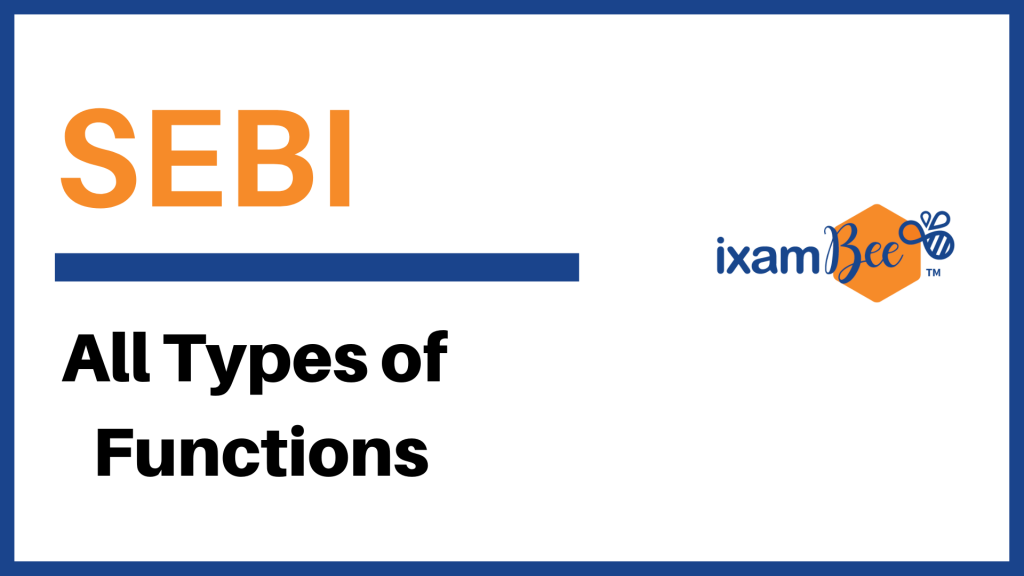The pivotal role played by the Securities and Exchange Board of India (SEBI) in shaping the country’s financial landscape is unparalleled. Established in 1988 and granted statutory powers in 1992, SEBI emerged as the authoritative regulator of the securities market. Headquartered in Mumbai with regional offices strategically located, it replaced the Controller of Capital Issues. Comprising a Chairman and eight members, including representatives from the Union Finance Ministry and the Reserve Bank of India, SEBI has been a key player in fostering transparency and stability in India’s investment sphere.
SEBI’s functions extend far beyond mere regulation; it is the guardian of integrity in the securities market. Empowered by the SEBI Act of 1992, the board exercises its authority to maintain fair practices and prevent malpractices within the financial sector. As the overseer of market intermediaries and the guardian of investors’ interests, SEBI is crucial in ensuring fair competition for all participants. With its roots in the evolution of financial governance in India, SEBI stands as a beacon of trust, steering the nation towards a robust and ethical financial ecosystem.

The significance of SEBI in India’s financial narrative cannot be overstated. SEBI has fostered investor confidence from its humble beginnings as a non-statutory body to its current status as an autonomous regulatory powerhouse. The board’s functions extend to policy formulation, market supervision, and enforcement, creating an environment where market participants can confidently thrive. As we delve deeper into SEBI’s multifaceted responsibilities, it becomes evident that its impact reverberates not only in the boardrooms of financial institutions but also in the lives of countless investors nationwide.
Functions of SEBI
Embark on a journey into the intricate workings of the Securities and Exchange Board of India (SEBI) as we unveil its multifaceted functions. From safeguarding investor interests to oversee financial market operations, SEBI plays a pivotal role in shaping India’s securities landscape. In this exploration, we delve into SEBI’s protective, regulatory, and developmental functions, unraveling its comprehensive oversight of market intermediaries and its commitment to fostering fair practices. Join us in understanding how SEBI’s initiatives contribute to the resilience and dynamism of the Indian securities market.
- Protective Functions of SEBI: Safeguarding Investor Interests: SEBI, as a quasi-judicial entity, prioritizes the protection of investors and financial participants. Its initiatives include promoting fair practices, creating investor awareness, and prohibiting fraudulent and unfair trade practices. By establishing a regulatory framework, SEBI ensures a secure environment for all stakeholders in the securities market. SEBI actively monitors market activities through periodic audits and investigations to swiftly identify and address potential threats, reinforcing its commitment to investor protection.
- Regulatory Oversight: Monitoring Financial Market Operations: A critical facet of SEBI’s role lies in regulating the functioning of businesses in financial markets. This involves levying fees, overseeing credit rating agencies, and managing the regulation of takeover processes for companies. SEBI fosters a transparent and accountable financial market ecosystem through stringent regulatory measures. Additionally, SEBI collaborates with market participants to formulate and update regulations, ensuring that the regulatory framework remains adaptive and responsive to the developing dynamics of the financial landscape.
- Development Functions: Nurturing a Robust Financial Landscape: SEBI’s developmental functions encompass a range of activities, from conducting research to encouraging self-regulating organizations and providing training to intermediaries. By actively participating in the growth and evolution of the financial sector, SEBI contributes to the development of a dynamic and resilient market infrastructure. It continuously explores innovative financial instruments and market practices, fostering an environment conducive to sustainable economic growth and investor confidence.
- Comprehensive Oversight: Regulating Various Market Intermediaries: SEBI’s purview extends to the regulation and registration of stockbrokers, sub-brokers, share transfer agents, bankers to an issue, trustees of trust deeds, merchants bankers, underwriters, portfolio managers, and other associated intermediaries. This comprehensive approach ensures that all entities connected with the securities market adhere to established standards. Regular inspections and compliance checks are conducted to maintain the integrity and efficiency of the market.
- Investor Education and Awareness: The Role of SEBI’s Investor Protection and Education Fund: SEBI, recognizing the importance of investor education, established The Investor Protection and Education Fund. This initiative underscores the commitment to empower investors with knowledge, fostering a more informed and vigilant community of market participants. Through various outreach programs and collaborations with educational institutions, SEBI strives to enhance financial literacy, enabling investors to confidently make informed decisions and navigate the complexities of the securities market.
- Securities Appellate Tribunal (SAT): Adjudicating Disputes: SAT, established under the Securities and Exchange Board of India Act, 1992, serves as a statutory body. Its primary purpose is to hear and dispose of appeals against orders passed by SEBI or adjudicating officers. SAT plays a crucial role in ensuring a fair and impartial resolution of disputes within the regulatory framework. Its decisions set essential precedents, contributing to the continuous refinement of regulatory practices in the financial sector.
- Ensuring Fair Practices: Core Objective of SEBI’s Protective Functions: Within its protective functions, SEBI focuses on maintaining fair practices in the securities market. This includes monitoring and preventing fraudulent activities, creating an equitable playing field for investors, and instilling confidence in the overall integrity of the market. SEBI actively collaborates with market participants to develop and enforce codes of conduct that promote fairness, transparency, and ethical behavior.
- Regulation of Takeovers: SEBI’s Oversight in Corporate Transitions: SEBI’s regulatory functions extend to overseeing the process of takeovers in companies. By establishing guidelines and regulations, SEBI ensures that corporate transitions occur transparently and regulated, safeguarding the interests of shareholders and maintaining market stability. The regulatory framework is regularly updated to address emerging challenges and align with global best practices in corporate governance.
- Training Intermediaries: SEBI’s Contribution to Professional Development: SEBI actively imparts training to intermediaries as part of its developmental functions. This proactive approach enhances the professional capabilities of market participants, contributing to a skilled and knowledgeable workforce within the financial sector. SEBI collaborates with industry experts and educational institutions to design and deliver training programs that keep intermediaries abreast of regulatory changes, market trends, and best practices.
- Research Initiatives: SEBI’s Commitment to Informed Decision-Making: SEBI’s developmental functions include researching to stay abreast of market trends and dynamics. By fostering a culture of research and analysis, SEBI contributes to the continuous improvement and adaptability of the Indian securities market. The insights gained from research initiatives inform policy decisions, ensuring that regulatory measures are well-informed, forward-looking, and responsive to the developing needs of the financial ecosystem.
Also Read: Interesting Facts About SEBI
Advantages of a Career with SEBI
Joining SEBI signifies entering a realm of unparalleled professional growth and contribution to the financial landscape. Established in 1988 as a non-statutory body, SEBI has emerged as a regulatory powerhouse dedicated to ensuring the integrity and efficiency of the securities market. The annual SEBI Grade A Officer recruitment, spanning streams like Grade A, Legal, Information Technology, Rajbhasha, Research, and more, beckons professionals seeking dynamic roles in financial regulation.
- Diverse Career Streams: Tailoring Expertise to Impact: SEBI’s recruitment spectrum covers general, legal, Information Technology, engineering (Electrical), research, and Official Language streams, allowing individuals to align their expertise with their career goals. The diverse avenues empower professionals to contribute meaningfully to financial governance.
- Commitment to Talent Acquisition: SEBI Grade A Exam 2025: The recently released SEBI Grade A Notification for 2025 underscores SEBI’s commitment to attracting top-tier legal talent. Prospective Law Officers can access detailed exam information on our website, facilitating thorough preparation and ensuring a level playing field for all aspirants.
- Transparent and Efficient Recruitment Processes: SEBI’s commitment to transparent and efficient recruitment processes is evident in its systematic approach to hiring. The organization ensures that all recruitment-related information, from job notifications to results, is promptly and openly communicated through its official channels. SEBI’s dedication to transparency fosters a fair and inclusive environment for candidates, where every step of the recruitment process is transparent and accessible. This commitment reinforces SEBI’s integrity and reflects its dedication to attracting and selecting the best talent to contribute to the dynamic field of financial regulation.
- Intellectual Stimulation: Shaping the Regulatory Landscape: SEBI offers a stimulating environment for professionals seeking intellectual challenges. Working at the forefront of financial regulation allows individuals to shape and influence the regulatory landscape, contributing to the stability and credibility of India’s securities market. Besides, the SEBI Grade A salary is notably competitive, reflecting the recognition of these officers’ pivotal role in regulating and maintaining the integrity of India’s securities market.
- Values-Driven Culture: Innovation, Integrity, and Excellence: A career with SEBI goes beyond professional growth, encompassing a values-driven culture that prioritizes innovation, integrity, and the pursuit of excellence. Joining SEBI means becoming part of an organization that recognizes the importance of these values in maintaining the trust and confidence of market participants and the public.
Prepping for SEBI Recruitment Exams with ixamBee: A Comprehensive Guide
ixamBee is an indispensable resource for individuals gearing up for SEBI Grade A recruitment exams. The platform not only furnishes essential details about the SEBI Grade A exam pattern and syllabus, including the number of phases, subjects, and marking scheme, but also delves into the intricacies of the eligibility criteria. This comprehensive information empowers candidates, providing a solid foundation for their exam preparation journey. Let’s examine how ixambee can help to aspire candidates clear their SEBI recruitment exams.
- Online Course for SEBI Grade A: The ixamBee SEBI Grade A online course is a robust learning platform tailored to cater to diverse streams such as General, Legal, Information Technology, Engineering, Research, and Official Language. The course is crafted by seasoned faculty members with expertise in their respective fields, ensuring that candidates receive top-notch guidance. Through video lectures, live classes, and practice quizzes, ixamBee’s online course offers a well-rounded educational experience that aligns with the specific requirements of each stream.
- Mock Tests for SEBI Grade A: ixamBee recognizes the significance of realistic exam simulation in having adequate preparation. The platform’s meticulously crafted SEBI Grade A mock tests replicate the actual exam environment, enabling candidates to practice time management, refine their strategies, and identify areas for improvement. These mock tests cover all sections comprehensively, providing candidates with a holistic assessment of their preparedness.
- Previous Year Papers for SEBI Grade A: Drawing insights from past trends is integral to SEBI Grade A exam preparation, and ixamBee facilitates this through access to an extensive collection of SEBI Grade A previous year papers. By analyzing these papers, candidates gain valuable insights into question patterns, topic weightage, and overall exam dynamics, allowing them to tailor their preparation strategies accordingly.
- Interactive Learning Modules: The online course on ixamBee integrates interactive learning modules to create an engaging and dynamic study experience. Video lectures, live classes, current affairs classes through Beepedia, and practice quizzes are interactive tools that ensure candidates grasp complex concepts effectively. This diverse approach accommodates different learning preferences, fostering an environment conducive to comprehensive understanding.
- Doubt Resolution Sessions: Understanding that clarity is paramount in exam preparation, ixamBee organizes doubt resolution sessions. These sessions provide candidates with a platform to interact with experienced faculty, seek clarifications on challenging topics, and address any lingering doubts. This personalized approach enhances candidates’ understanding and boosts their confidence as they approach the exam.
- Performance Analytics and Feedback: ixamBee goes beyond just providing study material; it offers performance analytics and feedback to facilitate a data-driven approach to preparation. Candidates can track their progress, identify strengths and weaknesses, and receive personalized feedback through these features. This invaluable insight empowers candidates to refine their study plans, focusing on areas that need improvement and optimizing their overall exam strategy.
Summing Up
SEBI (Securities and Exchange Board of India) is the paramount authority in regulating and empowering the Indian capital market. Its pivotal role is evident in the consistent release of annual guidelines strategically designed to encompass all participants in the securities market. These guidelines serve as a regulatory compass, ensuring fair and smooth functioning and fostering an environment where investors, issuers, and financial intermediaries can operate with confidence and integrity.
If you’re preparing for the SEBI Grade A Exam, ixamBee is your ultimate guide to success! Boost your preparation with our SEBI Grade A Mock Tests and SEBI Grade A Phase 1 PYP to understand the exam pattern and improve your performance. Enroll in our SEBI Grade A Phase 1&2 Online Course for expert guidance. Also, check out our Target Banking Online Course for comprehensive banking exam preparation. Start now with ixamBee!
ixamBee specializes in providing expert guidance and resources for banking exams 2025, ensuring that you are well-prepared for the Upcoming Bank Exams like RBI Grade B, NABARD Grade B, IBPS SO, and more. Our courses align with the bank exam calendar 2024, covering all the essential topics. With a focus on the upcoming bank jobs, our Previous Year Papers, BeePedia, SSC CGL, SSC CHSL, SSC MTS and other Mock Tests are designed to help you excel in upcoming banking exams.
Also Read:
How to Prepare for Sebi Grade A Exam in Less Time
SEBI Grade A Interview 2025: Interview Preparation for General & Research Stream
SEBI Grade A 2025: Prelims Previous Years Cut off









![List of Joint Military Exercises of India [2020]](/blog/wp-content/uploads/2020/03/Copy-of-Blog-new-11-218x150.png)



